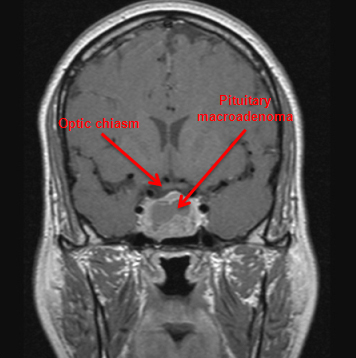Etiology
Human pituitary adenomas, including prolactinomas, are monoclonal in origin.[3] This suggests that pituitary tumors arise from the proliferation of single, mutated pituitary cells, where somatic cell mutations stimulate cellular growth rate. The majority of prolactinomas occur sporadically. A small percentage of patients may have multiple endocrine neoplasia syndrome type 1 (MEN-1) or familial isolated pituitary adenoma (FIPA). In studies of FIPA patients, prolactinomas associated with aryl hydrocarbon receptor-interacting protein (AIP) gene mutations were large, occurred at a young age (<30 years), were invasive, had suprasellar extension, and were resistant to dopamine agonist treatment.[4][5] Consideration should be given to screening young patients (<40 years) presenting with large prolactinomas for AIP gene mutations and MEN-1.[6][7]
Pathophysiology
Prolactinomas are anterior pituitary lactotroph tumors. Hypersecretion of prolactin causes secondary hypogonadism via its inhibitory effects on gonadotropin-releasing hormone and pituitary gonadotropins. Dopamine is transported from the hypothalamus to the anterior pituitary by hypophysial portal vessels, where it inhibits prolactin secretion via dopamine receptors expressed by lactotrophs. Therefore, disruption of dopamine secretion or transport to the portal vessels can lead to hyperprolactinemia.
Classification
Classification according to tumor size
Microadenomas:
Small, intrasellar tumors, <10 mm in diameter
Rarely increase in size
Most common type in women.
Macroadenomas:
Larger tumors, >10 mm in diameter
Usually locally invasive into the suprasellar or parasellar regions
Sometimes associated with aggressive compression of vital structures
Men and postmenopausal women more commonly present with large and invasive adenomas, occasionally giant tumors (4 cm or greater)
Almost invariably benign (malignant prolactinomas that metastasize outside the pituitary sella are very rare).[Figure caption and citation for the preceding image starts]: Gadolinium-enhanced magnetic resonance imaging showing a left-sided 7 mm pituitary microprolactinomaFrom the collection of Dr Ilan Shimon [Citation ends].
 [Figure caption and citation for the preceding image starts]: Gadolinium-enhanced magnetic resonance imaging showing a large pituitary macroadenoma in a 45-year-old man with hyperprolactinemiaFrom the collection of Dr Ilan Shimon [Citation ends].
[Figure caption and citation for the preceding image starts]: Gadolinium-enhanced magnetic resonance imaging showing a large pituitary macroadenoma in a 45-year-old man with hyperprolactinemiaFrom the collection of Dr Ilan Shimon [Citation ends].
Use of this content is subject to our disclaimer